The extensive predation [by wolves] on the caribou, especially on the calves, is apparently an important check on their numbers. Adolf Murie, Wolves of Mount McKinley, 1944
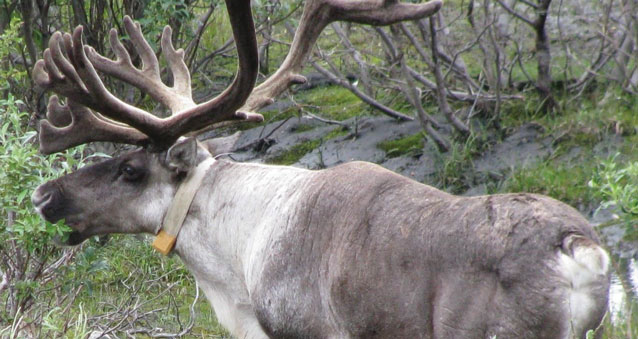
Layne Adams
What interesting story can you share about caribou in Denali?
When quizzed, Dr. Layne Adams, of the U.S. Geological Survey, Alaska Science Center, who has been studying the Denali Caribou Herd since 1986, did not hesitate.
“Just when you think you have them figured out, they surprise you. For example, the herd’s normal movements pretty much occur within Denali National Park and Preserve, but in September 1992, following a severe early snowstorm, most of the caribou made a mass exodus out of the park, streaming onto the Nenana River north of Healy.
They kept heading north, many passing right through Fairbanks, and ultimately wintered in the hills north and east of Fairbanks—up to 140 miles (220 km) from their normal range. Prior to this, caribou had not been observed near Fairbanks since 1947, so none of those individuals had made the trip before, and they haven’t done anything like it since. These atypical movements largely defy explanation.”
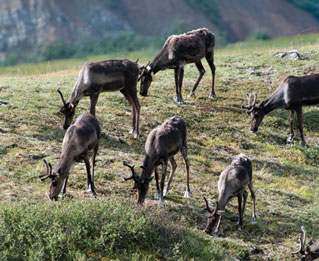
Layne Adams
Denali Caribou Herd and Other Herds in Alaska
Alaska is home to about 700,000 caribou divided among 32 recognized herds. Seven herds number from 30,000 – 235,000 caribou, accounting for about 95% of caribou in the state.
These large herds, such as the Western Arctic Herd, are characterized by their sheer numbers, impressive long-distance seasonal migrations, and high concentrations on traditional calving grounds, which serve to increase early calf survival by overwhelming local predators with lots of calves.
Each of the remaining 25 herds, including the Denali Herd, number fewer than 3,000 caribou and are more sedentary, making shorter seasonal migrations (often simply altitudinal shifts). Given their markedly lower numbers and more dispersed distribution at calving, these herds tend to experience high levels of predation on calves during their first weeks.
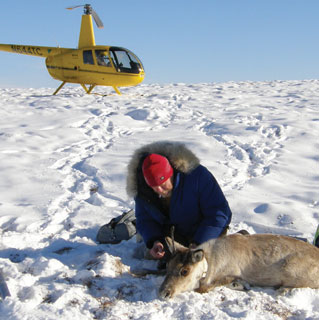
Layne Adams
Studying Denali’s Caribou
The Denali Caribou Herd is ideal for studying natural factors that influence caribou populations because the herd ranges almost entirely within Denali (see map on reverse), where human harvests of large predators (wolf, grizzly bear, black bear) and their ungulate prey (sheep, moose, caribou) are minimal, so natural processes predominate.
Since 1986, Dr. Adams has focused on annual assessments of the herd’s basic population dynamics (herd size and trend, adult sex composition, adult female survival, and calf production and survival). He also has investigated the characteristics of calf mortality (1986-1997), and the growth patterns and survival of male caribou (2007-2015).
To study the herd, Adams captures caribou by darting them with immobilizing drugs from a helicopter, and fits them with radiocollars. Most caribou are captured initially at 10 months of age and are followed throughout their life time. The radiocollars allow Adams to periodically locate caribou within the herd for population surveys, as well as to monitor the productivity and survival of individual caribou.
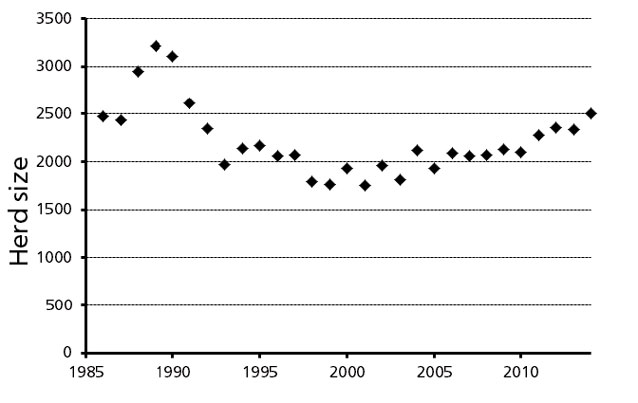
What Influences Population Size?
Over the years, Adams has been able to connect population size of the Denali Herd with winter severity (snow depth) and calf survival, as well as the age structure of cows (older cows are more prone to mortality and produce fewer calves).
During the mild winters of most of the 1980s, annual survival of caribou cows was high (~96% per year) and about 50% of calves were “recruited” into the population each fall, resulting in ~7% annual growth (see graph at right). By Fall 1989, there were 3,200 caribou. With severe winters beginning in 1989, caribou numbers declined in three years by nearly a third to 2,300. Adult cow survival dropped to 85% and only about 10% of calves made it to fall.
During 1993-2003, moderate winter snowfalls returned, but the caribou herd continued in a slow decline, primarily because calf recruitment remained very low (~15%). With few young cows added to the herd during the long stretch of low recruitment, the female age structure became heavily weighted towards older females (24% were at least 13 years old in May 2002).
As a result, adult female survival declined markedly during 2000-2004 as these old females died. After 2004, adult female survival improved to 91% with the shift to a younger age structure, and fall calf recruitment increased to ~27%, allowing for limited growth of the herd. Preliminary results from Fall 2014 indicate the herd numbers about 2,500 caribou.
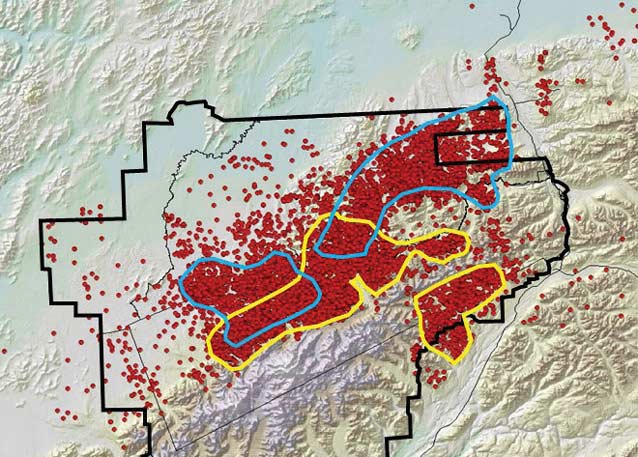
Causes of Calf Mortality
In their first 15 days of life, caribou calves are very vulnerable to predation and, on average, over half the calves die during this period. Bears and wolves account for more than 80% of calf deaths. Another 10% of the deaths are caused by golden eagles, wolverines, and coyotes. The remaining mortalities are due to problems at or near birth, and from occasional accidents. Once a calf is two weeks old, its chance of survival improves substantially.
Growth and Survival of Bull Caribou
Bull caribou in Denali fall roughly into three size classes (see photos below). Small bulls look similar to cows; most are yearlings, but they can be up to 3 years old. Medium-sized bulls (2 to 4 years old primarily) are noticeably larger than cows, but their antlers are spindly with fewer points than the fully-mature bulls. Large, fully-mature bulls are 4 to 12 years old, weigh 400 to 600 lbs (180 to 270 kg), and grow well-developed antlers that measure 3 to 5 ft (90 to 150 cm) along the contour of the main beam.
Young bulls up to 4 years of age add on about 60 lbs (27 kg) each year. During these years, their annual survival is about 90%, and their role in the fall breeding season, or rut, is probably limited. By 5 years old, bulls are fully mature and weigh an average of 500 lbs (230 kg) prior to the fall rut. For a period of 3 to 4 weeks of fighting and breeding, they do not eat and lose one-third of their body mass. From age 5 to 7 years, a bull’s annual survival is reduced to ~78% due to the stresses of the rut. After this, survival declines steeply with very few bulls living beyond 9 years. In comparison, female caribou exhibit annual survival of ~90% and can live for 20 years.

Layne Adams
Although Adams expected the highest mortality of mature bulls in late September to November, during and immediately following the rut, he was surprised to find that over 40% of the annual mortality occurs during mid-June to mid-September prior to the rut when males are in peak condition. Adams suspects that, given the demand to replenish the substantial body reserves they lose each year, these large bulls are spending time in thickets of tall shrubs where they can maximize their intake of high-quality forage. However, foraging there comes at the high cost of increased risk of predation, primarily by wolves. To investigate this hypothesis, Adams collared bulls in 2014 with state-of-the-art GPS collars, which provide regular and highly accurate locations.
Always New Insight
Even after studying Denali’s caribou for nearly 30 years, Adams still gets excited with each insight gained—whether it is caribou migrating in droves from the park, or bull caribou that die when least expected. His work continues to provide important understanding of the status and trends of Denali’s wildlife.
Last updated: April 21, 2016
